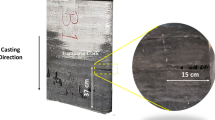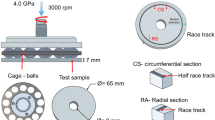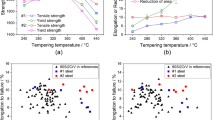Abstract
This investigation was aimed at understanding the mechanism of hot-shortness in AISI 12L14 + Te steels, which might lead to a hot-rolling practice to minimize the high yield losses in this grade. High temperature tensile tests showed a pronounced loss in ductility between 810 and 1150 °C, the embrittlement being most severe at about 980 °C. Electron microprobe studies confirmed thermodynamic stability data which indicated that tellurium occurs primarily as PbTe in this steel composition. SEM fractography revealed increasingly brittle, partially intergranular tensile fracture with a loss of ductility. Auger Electron Spectroscopy of samples quenched from the embrittlement temperature range indicated the formation of a thin film of PbTe on the grain boundary surfaces. All these results are consistent with a mechanism of liquid metal embrittlement by PbTe which has a melting point of 923 °C. Some theoretical considerations of this mechanism are discussed. The characteristic return to ductility above the embrittlement range suggests that rolling at temperatures above 1150 °C might minimize the hot-shortness problem. Results of limited hot-rolling experiments to study the incidence of surface cracking as a function of temperature support the above suggestion.
Similar content being viewed by others
References
G. T. Brown: Report No. 787, GKN Group Technological Centre, Wolverhampton, U.K., September, 1965.
G. T. Brown: Report No. 911, GKN Group Technological Centre, Wolverhampton, U.K., June, 1967.
G. Odin, R. Leveque, M. Aucey, and P. A. Portevin:Rev. Met., 1968, vol. 65, p. 363.
M. Hugo, J. Bellot, J. Frey, and M. Gantois:Rev. Met., 1971, vol. 68, p. 397.
W. E. Heitmann and M. G. Wright: U.S. Patent No. 3,382,700, May 4, 1968.
N. P. Seah:Surface Science, 1975, vol. 53, p. 168.
M. Hansen:Constitution of Binary Alloys, McGraw Hill Book Company, 1958.
R. P. Elliott:Constitution of Binary Alloys, First Supplement, McGraw Hill Book Company, 1965.
R. Hultgren, R. L. Orr, P. D. Anderson, and K. K. Kelley:Selected Values of Thermodynamic Properties of Metals and Alloys, University of California, 1971.
G. M. Lukashenko, R. I. Polotskaya, N. Abrikosov:Khim. Suyaz Poluprov., Polumetallakh, 1972, p. 333.
K. B. Sadykov and S. A. Semenkovich:Izv. Akad. Nauk SSR, Fiz Tekhn. Khim i Geol Nauk, 1966, vol. 2, p. 16.
A. W. Douglas, W. E. Heitmann, and E. S. Madrzyk:Trace Additives: Bismuth, Selenium, and Tellurium in Iron and Steel, ASM Symposium, 1970, p. 143.
G. Hallerman, Unpublished Research, Inland Steel Company, 1969.
W. J. M. Salter and F. B. Pickering:J. Iron Steel Inst., 1967, vol. 205, p. 973.
T. B. Smith and D. B. Clayton:Nature, 1963, vol. 198, April 27, p. 380.
A. N. Krestovnikov and N. N. Glagoleva:Akad. Nauk SSSR, 1965, vol. 162, p. 94.
S. Mostovoy and N. N. Breyer:Trans. ASM, 1968, vol. 61, p. 219.
N. N. Breyer and K. L.Johnson:J. of Testing and Evaluation, 1974, vol. 2, no. 6, p. 471.
J. C. Lynn, W. R. Warke, and P. Gordon:Mater. Sci. Eng., 1975, vol. 18, p. 51.
W. R. Warke and N. N. Breyer:The Effect of Lead on Micro-Crack Initiation and Propagation in Alloy Steels, Tech. Report No. 10752, U.S. Army Tank Command, 1969.
D. C. Huffaker: Inland Report No. 274.2.2,Hot Tensile Properties of Various Carbon and Free-Machining Steels, December 29, 1971.
C. J. McMahon:Temper Embrittlement in Steel, ASTM STP, 1968, vol. 407, p. 127.
H. L. Marcus and P. W. Palmberg:Trans. TMS-AIME, 1969, vol. 245, p. 1664.
A. Joshi and D. F. Stein:Corrosion-NACE, 1972, vol. 28, p. 321.
R. D. Zipp, W. R. Warke, and N. N. Breyer:ElectronMicro-fractography, ASTM STP 453, 1968, p. 111.
L. E. Davis, N. C. MacDonald, P. W. Palmberg, G.E. Riach, R. E. Weber:Handbook of Auger Electron Spectroscopy, Second Edition, Physical Electronics Industries, Inc., Eden Prairie, MN, 1976.
A. R. C. Westwood, C. M. Preece, and M. H. Kamdar:Trans. ASM, 1967, vol. 60, p. 723.
A. A. Kelly, W. R. Tyson, and A. H. Cottrell:Phil. Mag., 1967, vol. 15, p. 567.
P. Gordon:Met. Trans. A, 1978, vol. 9A, p. 267.
M. Guttman:Met. Trans. A, 1977, vol. 8A, p. 1383.
N. A. Gjostein:Diffusion, ASM, Metals Park, Ohio, 1973.
C. S. Kennedy, Unpublished Results, Inland Steel Company, East Chicago, IN, 1969.
O. I. Tananaeva, R. A. Sapozhnikov, and A. V. Novoselova:Izv. Akad. Nauk. SSSR, Neorg. Mater., 1969, vol. 5, p. 737.
Author information
Authors and Affiliations
Additional information
Formerly with the Inland Steel Research Laboratories.
Rights and permissions
About this article
Cite this article
Bhattacharya, D., Quinto, D.T. Mechanism of hot-shortness in leaded and tellurized free-machining steels. Metall Trans A 11, 919–934 (1980). https://doi.org/10.1007/BF02654705
Received:
Issue Date:
DOI: https://doi.org/10.1007/BF02654705




